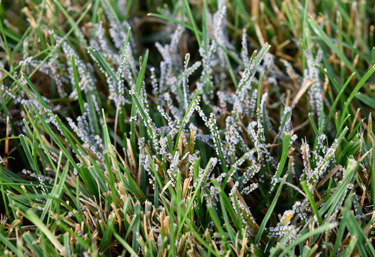A lawn to love
A long hot summer leaves most lawns looking worse for wear. It’s time for some renovation that will soon have lawns looking loved again.
Brown bare patches are not only an eyesore. If we’re not quick to remedy them, they’re an invitation for weeds. Pet urine, lack of water and compaction from heavy use are all contributing factors, but dead patches in the lawn can also be caused by diseases and insect pests. In late summer and autumn common lawn insect pests reach the peak of their destructive activity. It’s a good time to lift one of the dead patches and see what’s underneath. Safe and easy-to-use lawn insect control is available at your garden centre.
Beetles and grubs
Grass grubs can be found just beneath the surface. About 25 mm long, pale cream coloured with a brown head and six legs, they’ll stop moving and curl into a “C” shape when disturbed. The common grass grub is the laval stage of the New Zealand bronze beetle, Costelytra zealandica, our most ubiquitous lawn pest. In spring the adult beetles hatch from underground pupae, feeding on grass, trees and shrubs while they lay eggs in the lawn. When the grubs hatch from the eggs they start feasting on lawn roots, passing through three ‘instars’ as they shed their skin between growth spurts. In late summer brown patches start showing up in the lawn as the fully grown grubs are at their most destructive stage, their third and final instar. Another member of the beetle family that causes similar damage to lawns is the black beetle from Africa, but this one needs a warm climate and is found only in the North Island.
Moths and caterpillars
When a porina moth lays her eggs in your lawn, the resulting larvae is a caterpillar. The damage is easily mistaken for grass grub, but this time it is not the roots that are eaten, but the leaves. Porina moths comprise several different species of native NZ moths (Wseana spp.). The caterpillars grow up to 7cm long as they chomp their way through lawns. They hide in the soil, emerging at night to graze. Look closely and you may find the entrances to their tunnels on the soil surface. Smaller caterpillars that invade lawns are known as sod webworms. Sod webworms also feed at night. Like porina caterpillars, their feeding results in bare patches, and subsequent weeds.
Crickets
Black crickets are also a north island problem, occurring as lawn pests in Northland, Auckland, Waikato, Bay of Plenty, Hawkes Bay, Taranaki and Manawatu. They prevail in hot dry summers, sheltering in soil cracks. Unlike beetles and moths, they don’t have a pupa stage. Once hatched from the egg, the nymphs look like miniature adults except for their lack of wings. Nymphs and adults devour grass leaves and germinating seeds. They’re especially fond of rye grass.
Lawn diseases
Common lawn diseases include brown patch, dollar spot, fusarium, rust and red thread. It is a good idea to choose a lawn seed blend that is resistant to fungus diseases. To prevent disease on new lawns, top brands of lawn seed have a fungicide coating. Disease is usually associated with wet humid weather and can be worse when there is a buildup of thatch (old grass clippings and other organic matter). Use a scarifier rake to remove thatch (or hire an expert with a machine for a big lawn). Spray with an appropriate fungicide at the first sign of disease to prevent major outbreaks.
Autumn Makeover
Revitalising a parched and patchy lawn
Removing thatch once a year helps keep your lawn healthy. Use a scarifying rake or machine to remove the buildup of dead grass and organic matter. This restores the passage of air water and nutrients.
Aerate the soil to reduce compaction, improve water absorption and supply lawn roots with oxygen. Use a garden fork to punch holes and aerate the soil. For very hard compact or large lawns, a ‘core aerator’ machine may be hired.
Weeds love dry hungry lawns and can be kept to a minimum with regular feeding and mowing. Avoid mowing too low in summer. Small numbers of weeds can be dealt with by hand, otherwise special lawn weed sprays are available. However, don’t spray new lawns with weedkiller for at least two months after sowing.
Moss appears in shady, poorly drained, compacted or poorly fed lawns. Moss killers can be sprayed in spring or autumn but the moss will reappear if conditions remain the same. Consider re-landscaping with plant groundcover plants in shady areas or lay stepping stones in heavy traffic areas.
Re-sow brown patches. Prepare the ground first, so that the seed can make good contact with the soil; mow the lawn short then rake to remove thatch and create shallow grooves in the soil. Add a layer of weed-free topsoil or lawn mix, then scatter the seed and water gently. Feed and water as for a new lawn.
Sunken areas that have a good cover of turf may be remedied without sowing any seed: Cut and peel back a section of turf and fill underneath with topsoil or lawn mix. Carefully replace the turf and water thoroughly.
Feed with lawn fertiliser to support the flush of growth. A good lawn fertiliser contains the correct proportions of nitrogen and other essential nutrients.
Water during dry weather. Lawns need water to stay green and a newly sown lawn must not be allowed to dry out. If you have summer water restrictions, choose a drought tolerant lawn variety.

8-Mar-2018

The backyard lawn, fresh green in spring.

The same backyard lawn at the end of a long hot summer.

The tell-tale castings of porina caterpillar on lawn.

Slime mould, which does little harm but looks unsightly, and rust (bright orange, lower right) on fescue.

